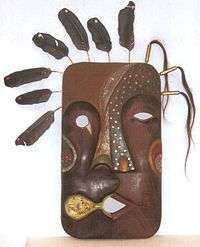Koyukon
|
Poldine Carlo, Koyukon author, 2007 | |
| Regions with significant populations | |
|---|---|
| 2,300[1] | |
| Languages | |
| English, Koyukon | |
| Religion | |
| Christianity, Animism | |
| Related ethnic groups | |
| Deg Hit'an, Gwich'in, other northern Athabaskan peoples | |
The Koyukon are an Alaska Native Athabaskan people of the Athabaskan-speaking ethnolinguistic group. Their traditional territory is along the Koyukuk and Yukon rivers where they subsisted by hunting and trapping for thousands of years. Many Koyukon live in a similar manner today.
The Koyukon language belongs to a large family called Na-Dené or Athabaskan, traditionally spoken by numerous groups of native people throughout northwestern North America. In addition, due to ancient migrations of related peoples, other Na-Dené languages, such as Navajo and Apachean varieties, are spoken in the American Southwest and in Mexico.
History
The first Europeans to enter Koyukon territory were Russians, who came up the Yukon River to Nulato in 1838. When they arrived they found that items such as iron pots, glass beads, cloth apparel, and tobacco had already reached the people through their trade with coastal Eskimos, who had long traded with Russians. An epidemic of smallpox had preceded them, causing high fatalities in the village. In subsequent years, European infectious diseases drastically reduced the Koyukon population, who had no immunity to them.
Relative isolation persisted along the Koyukuk until 1898, when the Yukon Gold Rush brought more than a thousand men to the river. They found little gold, and most left the following winter.[2]
"Distant time"

As the Koyukon reckon it, all things human and natural go back to a time so remote that no one can explain or understand how long ago it really was. However ancient this time may be, its events are recounted accurately and in great detail through a prodigious number of stories.
The stories constitute an oral history of the Koyukon people and their environment, beginning in an age before the present order of existence was established. During this age "the animals were human"—that is, they had human form, they lived in a human society, and they spoke human (Koyukon) language. At some point in the Distant Time, certain humans died and were transformed into animal or plant beings, the species that inhabit Koyukon country today. These metamorphoses and shape shifting left a residue of human qualities and personality traits in the north-woods creatures.
Taken together, the Distant Time stories describe a primordial world and its transfiguration into modern form. The scope of Distant Time stories ranges from the minute to the cosmological. They explain the beginnings of entities that inhabit the sky—the sun, moon, and aurora. They account for certain weather phenomena, such as thunderstorms, which are understood as the transformed embodiment of a formerly human spirit.

At the end of Distant Time, there was a great catastrophe. The entire earth was covered by a flood. Under the Raven's supervision a pair of each species went aboard a raft. These plants and animals survived, but when the flood ended, they could no longer behave like people. All the Distant Time humans had been killed, and so Raven recreated people in their present form. The Koyukon believe that nature is God, which is why they must respect it.
Notable Koyukon
- Walter Harper, first man known to reach the summit of Denali (Mount McKinley), in June 1913
- Morris Thompson (1938–2000), businessman and leader
- Kathleen Carlo-Kendall, professional carver artist
References
- ↑ Alaska Native Language Center : Alaska Native Languages / Population and Speaker Statistics
- ↑ Shannon Michele McNeeley (2009), Seasons out of balance climate change impacts, vulnerability, and sustainable adaptation in Interior Alaska, Fairbanks, Alaska, August 2009
Further reading
| Wikimedia Commons has media related to Koyukon. |
- Hunn, E.S. & Williams, N.M.(Eds.). (1982). Resource Managers: North American and Australian Hunter-Gatherers. Westview Press: Colorado. Nelson, R.K. “A Conservation Ethic and Environment: The Koykon of Alaska” p. 211-228 Rohrlich, R & Baruch, E. (Ed.). (1984).
- Naciente, Esperanza. "Indigenous Lifestyles: Lessons for the Industrialized World." Fighting For Freedom Because A Better World Is Possible Eds. Edgey Wildchild and Esperanza Naciente. New York: Planting Seeds Press. 2006. 121-126.
- Nelson, Richard K. Make Prayers to the Raven: A Koyukon View of the Northern Forest. Chicago: University of Chicago Press, 1986. ISBN 0-226-57163-7
- Nelson, Richard K., Kathleen H. Mautner, and G. Ray Bane. Tracks in the Wildland: A Portrayal of Koyukon and Nunamiut Subsistence. [Fairbanks]: Anthropology and Historic Preservation, Cooperative Park Studies Unit, University of Alaska, Fairbanks, 1982.
- Peter, Adeline. Iñuksuk: Northern Koyukon, Gwich'in & Lower Tanana, 1800-1901. Fairbanks, AK: Alaska Native Knowledge Network, 2001. ISBN 1-877962-37-6
| ||||||||||||||
